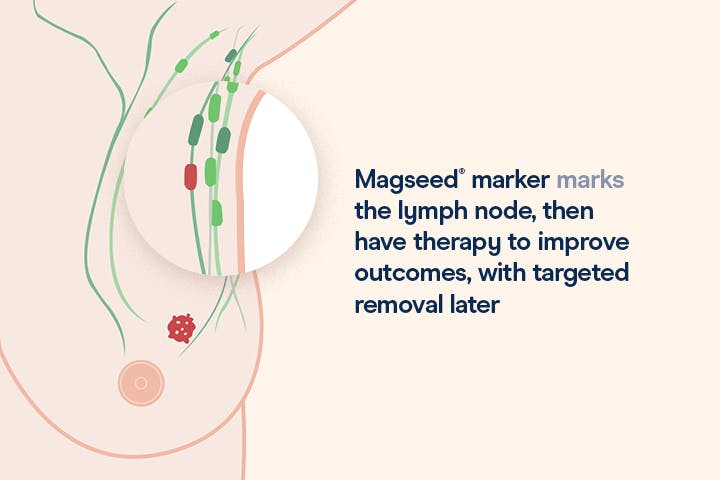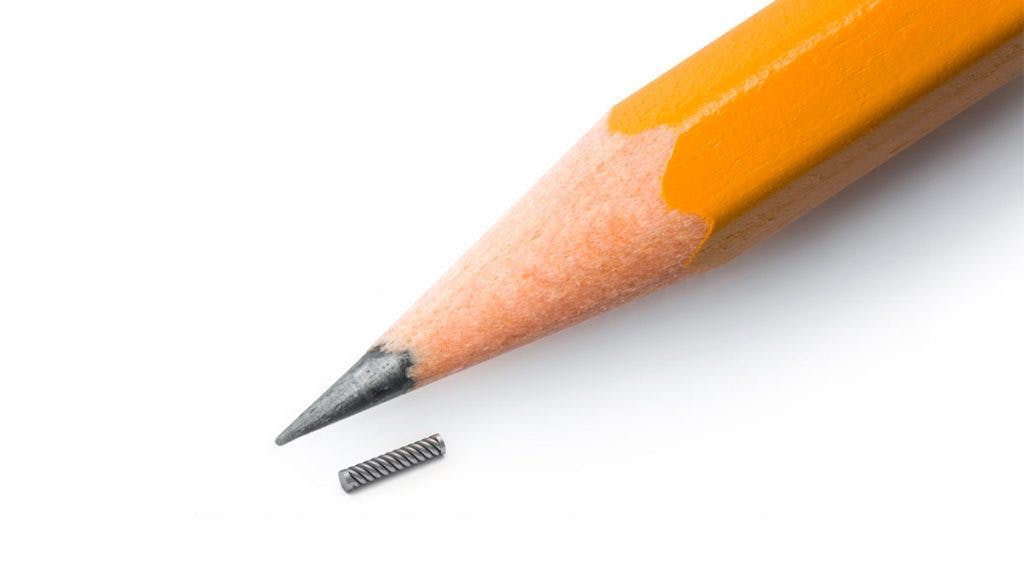Targeted axillary dissection with the Magseed® marker

What is targeted axillary dissection (TAD)?
Targeted axillary dissection (TAD) is a treatment that involves ‘marking’ cancerous lymph nodes in your underarm, using the Magseed® marker.
This will allow your surgeon to locate them after a course of neoadjuvant chemotherapy – chemotherapy which is given prior to surgery.
The ability to accurately find and remove these particular lymph nodes will allow your surgeon to better understand how you have responded to the chemotherapy treatment.
In addition to removing these nodes marked with a Magseed®, the TAD treatment also involves a procedure called a sentinel lymph node biopsy (SLNB). For this, Magtrace® lymphatic tracer or a similar tracer is injected into your breast, where it will migrate to additional lymph nodes in your underarm – the nodes most likely to contain cancer if it has spread.
This approach has become more commonplace, as studies have shown that chemotherapy given prior to surgery can shrink the tumor in the breast and turn a cancerous lymph node from ‘node positive’ (containing cancer) to ‘node negative’ (free of cancer).
With a response like this, patients can benefit from less invasive surgery.
Why have I been recommended for targeted axillary dissection (TAD)?
Your surgeon has chosen to perform ‘targeted axillary dissection’ (TAD) to stage your cancer and more accurately understand how it is responding to chemotherapy.
Ultimately, your surgeon wants to avoid as many potential complications as possible during surgery to remove cancerous lymph nodes from your underarm.
In many cases, the precision of TAD will help reduce the need for a more invasive procedure.
How will my surgeon mark my lymph node(s)?
Through imaging techniques such as x-ray or a mammogram, your cancerous node will be identified. The Magseed® will then be injected in to the node to sit inactive until it is time for scanning or surgical removal.

During chemotherapy, the Magseed® marker will stay firmly in place within the node it has marked, which means it can be rescanned regularly to see how the lymph node has responded to the therapy.
This gives the surgeon better information about the next steps they need to take. In most cases, your surgeon will then look to remove any nodes containing a Magseed®.
To learn more about the Magseed® marker, please read our patient guide.
The procedure - what can I expect?
The Magseed® marker is placed into your affected lymph node(s). With a ‘Magseed® localization’ procedure, you will attend a placement appointment at the radiology department of your hospital. You’ll be taken to an imaging room, where you will be talked through the procedure ahead of the Magseed® marker placement.
The radiology professional will apply an anesthetic gel to the area of your body where the marker will be injected. Your radiologist will then use either an ultrasound machine or mammography to identify the lymph node they want to mark.
Once they have found this precise location, they will inject the Magseed® marker into the lymph node, using their chosen imaging system, to ensure the seed is placed accurately and securely. This is a quick procedure that only takes a matter of minutes.
Once the seed is inserted, you may be invited to receive further imaging to ensure it is in the right place. These images will also be used by your surgeon later during your surgery.
Chemotherapy before surgery and re-scanning or screening
Following placement, you may be scheduled for chemotherapy treatment. Now that the Magseed® marker is securely placed in your breast, it will not be affected by or affect any other therapy you may receive that attempts to shrink or eliminate the cancer in your lymph node.
Your surgeon may wish to use routine mammograms or ultrasound to monitor the lymph node or the tumor in your breast. Magseed® can be safely used with these medical imaging techniques.
Thanks to the earlier placement of the Magseed® marker, your surgeon will be able to easily find the seed placed inside your lymph node – helping them to monitor the effects of your chemotherapy and determine if subsequent surgery is required.
Surgery
With your Magseed® marker already placed in the affected lymph nodes, you won’t need to make additional visits to the hospital prior to the day of surgery. If your surgeon is also using Magtrace® for the SLNB procedure, you can go straight to the operating room on the day of surgery.
The surgery to remove a node containing a Magseed® marker is a routine procedure for a breast surgeon. This will be combined with a routine SLNB to also remove any other lymph nodes where cancer might have spread.
During the surgery, your surgeon will use a magnetic probe to locate the Magseed® marker and Magtrace® liquid tracer (if applicable) – using the magnetic signal to accurately guide them to the lymph nodes that need to be removed. Lymph nodes that do not contain Magseed® or Magtrace® will be left undisturbed.
Depending on your response to the chemotherapy treatment, you may only require removal of two or three lymph nodes.
After surgery
Once your surgery is complete, your surgeon will send the node for analysis, where the results will be processed.
This can take some time, so if you do not hear back straight after surgery, try not to worry.
Where can I find out more?
If you have any more questions about your surgery, please do ask your surgeon or the hospital team.
Thousands of surgeons and radiologists from across the world now use the Magseed® marker. You can hear our interviews with a selection of these surgeons on our videos page.